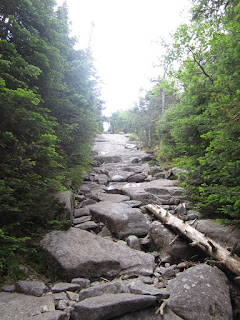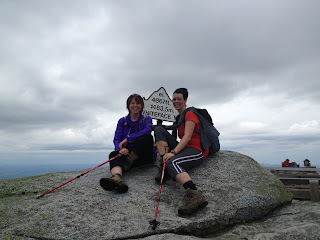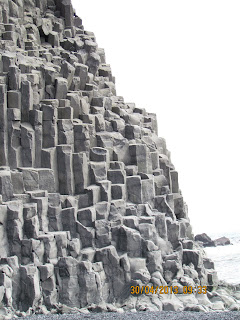Big Slide
Order in ranking: number 27
Last summer, while I was enjoying East Africa and Kilimanjaro, my 'dacks partner, Stephanie, went down for a couple of day trips and climbed Lower Wolfjaw and Big Slide. I managed to get down and climb Lower Wolfjaw last fall with the BF, but never got to do Big Slide.
So I went down this June to give it a shot. I'd asked a few friends if they were interested, and unfortunately no one would take the bait (seriously guys, stop saying "Someday" because someday you're going to be dead, and will never have done it. Someday might as well be today). So I drove down by myself and hiked up and over the Brothers to Big Slide, then down via John's Brook Lodge (well, not really, but close enough.)
I hated it. There, I said it. I hate Big Slide. Everyone will tell you that Big Slide is awesome, and you're going to love it (I know this because everyone told me it was awesome and that I would love it.) but for me, it was one giant sucky fail.
 It started off nice enough - the parking lot was mostly empty, which I've heard is true of most weekdays. Weekends and holidays the small parking lot (The Garden) fills up quickly, but there's a shuttle that runs from Marcy Field. Parking is $7, I think it recently increased. The shuttle is still $5, I believe.
It started off nice enough - the parking lot was mostly empty, which I've heard is true of most weekdays. Weekends and holidays the small parking lot (The Garden) fills up quickly, but there's a shuttle that runs from Marcy Field. Parking is $7, I think it recently increased. The shuttle is still $5, I believe.
I signed in at 8:46 and off I went. 10 minutes in, I had to return as I had forgotten my lunch in my car. 9:02, and I was off for the second time.
It was a pretty climb up to First Brother, and only moderately steep in places. For the most part, it was an easy, but uphill, climb. I think there are 8 or 9 rock ledges that you go over before you're at the summit; 3 and 4 sort of blend together, as do 6 and 7.
I assume the summit was close to where I found the rock cairn, I couldn't find any notes anywhere in my book about it, but it seems an apt spot to put a cairn, right? Otherwise, I have no idea what it was for.
After that, it's a quick easy climb to Second Brother, with a great view back over First Brother. I was making really great time at this point, I think it was only an hour in. I took a quick break for some food, then was off to conquer Third Brother, and then Big Slide.
I don't ever remember getting to the summit of Third Brother, so I'm assuming it was a treed summit, with maybe only a few views. I must have hit it, though, as I sat down to re-read the trail info from the High Peaks Book. I was getting a little worried about my water, and wanted to see how far I had come. It turns out I was pretty close to the trail marker for the trail split up Big Slide.
Once there, I quickly started up, stopping for a moment to shake my head at the wooded "ladder" leading up Big Slide. I hate these. Not the going up, but the coming down. But I was soon over them, and then scaling a log to stand in front of huge rock face wondering "How in the world do I get up this?"
Turns out you *don't*, or at least aren't supposed to. The log is there to block it off, the real trail is off to the left, and then up over a slightly less steep portion of rock face. Good thing to know! So after a brief set back, I got back on track and wound my way up the summit of Big Slide. Where I was promptly assailed by bugs. Lots of bugs. It was a calm day (threatening to rain, although it did hold off) so I'm assuming that a little wind would have blown those suckers away, but they did put a damper on my summit celebrations. It was a quick photo and then off I went again, planning to eat some lunch further down the mountain.
I breezed through most of the downhill portion (not the stairs, which I took my time over. I have a fear of heights and these stairs kill me) and managed to miss the trail marker going back to the Garden. It didn't matter, as I was on the right trail, but the first time I saw a red marker I was a little worried, so to note: It's a blue marker up the Brothers to Big Slide, a red marker down towards JBL and the Garden.
And this is where my dislike of Big Slide comes in. My boots have no grip. None. (They are so bad that I'm getting new ones, and I refuse to donate my old ones to charity because I don't want to be responsible for someone using them and getting into an accident). And as I stepped onto a dry rock, a boot slid out from underneath me. No problem, I caught myself before I fell, and I kept going.
Then the same thing happened on a root (note: I didn't trip. I didn't catch a toe or a heel or anything. My boot slid off the root) and I fell onto my right side. No problems, I feel onto moss/grass and it cushioned my fall. I kept going.
Then, third time being a charm, during a river crossing, I stepped onto the river bank (sloped rock) and....slid right into the river. That's right, I went right in. And, because I was sliding, I went in diagonally, so both boots were soaked, my pants, my top, my pack....everything. I was horizontal in the water at one point, and the current starting carrying me downstream.
I floundered and managed to get my feet under me and I stumbled to the shore where I took stock of the situation. I was wet, although items in my pack were relatively dry. I took off my socks (both climbing socks and liners) and wrung them out, before putting the climbing socks back on. I dumped out my boots, but there wasn't much to do. They had soaked up a lot of water, and I was just going to have to deal with wearing heavy, wet boots for the next 4 miles.
After that things got worse. I fell two more times - once on a river bank as I descended towards the water, and again as I came to the portion of the trail that actually descends (or ascends, if you're coming from JBL) the slide itself. And here I fell hard, cracking my right elbow on the bare rock, as well as my right hip and knee. I didn't break anything, but I have an impressive set of bruises. I decided that I couldn't get any wetter (or dirtier) and slid down the slide on my ass. The slide was mildly wet, not enough that it should have caused a problem, but it was wet enough to allow me to easily slide down.
Once I got off the mountain, and onto the even ground of the path back to the Garden, things improved. The path was incredibly muddy (they're in the process of improving trail conditions, and building new bridges over particularly muddy patches) but at this point I didn't care - my boots were wet enough, and dirty enough, that a bit of mud wasn't going to make a difference. I ploughed through and made good time back to the Garden, where I thankfully had a change of clothes (and shoes)
Important Notes:
- Go on a week day to ensure parking at the Garden
- Bring $7 for parking
- If going in spring/early summer, bring river shoes with you on the climb. You can change into them for the river crossings, and not have to worry about climbing in wet boots
- Markers are blue (up and over the Brothers to Big Slide), red (down Big Slide towards JBL/The Garden), yellow (off of Big Slide, on even ground towards the Garden)
- Summit was buggy
- Trail was very muddy back to the Garden
Total climbing time: 5 hours 34 minutes
Left trailhead at 9:02, returned at 2:36
Summited at 12:01
Order in ranking: number 27
Last summer, while I was enjoying East Africa and Kilimanjaro, my 'dacks partner, Stephanie, went down for a couple of day trips and climbed Lower Wolfjaw and Big Slide. I managed to get down and climb Lower Wolfjaw last fall with the BF, but never got to do Big Slide.
So I went down this June to give it a shot. I'd asked a few friends if they were interested, and unfortunately no one would take the bait (seriously guys, stop saying "Someday" because someday you're going to be dead, and will never have done it. Someday might as well be today). So I drove down by myself and hiked up and over the Brothers to Big Slide, then down via John's Brook Lodge (well, not really, but close enough.)
 | |
| Ah, home. (Stopped at construction, no picture taken while driving) |
I hated it. There, I said it. I hate Big Slide. Everyone will tell you that Big Slide is awesome, and you're going to love it (I know this because everyone told me it was awesome and that I would love it.) but for me, it was one giant sucky fail.
 It started off nice enough - the parking lot was mostly empty, which I've heard is true of most weekdays. Weekends and holidays the small parking lot (The Garden) fills up quickly, but there's a shuttle that runs from Marcy Field. Parking is $7, I think it recently increased. The shuttle is still $5, I believe.
It started off nice enough - the parking lot was mostly empty, which I've heard is true of most weekdays. Weekends and holidays the small parking lot (The Garden) fills up quickly, but there's a shuttle that runs from Marcy Field. Parking is $7, I think it recently increased. The shuttle is still $5, I believe.I signed in at 8:46 and off I went. 10 minutes in, I had to return as I had forgotten my lunch in my car. 9:02, and I was off for the second time.
It was a pretty climb up to First Brother, and only moderately steep in places. For the most part, it was an easy, but uphill, climb. I think there are 8 or 9 rock ledges that you go over before you're at the summit; 3 and 4 sort of blend together, as do 6 and 7.
 |
| This may, or may not, be a summit. |
After that, it's a quick easy climb to Second Brother, with a great view back over First Brother. I was making really great time at this point, I think it was only an hour in. I took a quick break for some food, then was off to conquer Third Brother, and then Big Slide.
I don't ever remember getting to the summit of Third Brother, so I'm assuming it was a treed summit, with maybe only a few views. I must have hit it, though, as I sat down to re-read the trail info from the High Peaks Book. I was getting a little worried about my water, and wanted to see how far I had come. It turns out I was pretty close to the trail marker for the trail split up Big Slide.
 |
| Worst type of ladder/stairs ever invented. |
Turns out you *don't*, or at least aren't supposed to. The log is there to block it off, the real trail is off to the left, and then up over a slightly less steep portion of rock face. Good thing to know! So after a brief set back, I got back on track and wound my way up the summit of Big Slide. Where I was promptly assailed by bugs. Lots of bugs. It was a calm day (threatening to rain, although it did hold off) so I'm assuming that a little wind would have blown those suckers away, but they did put a damper on my summit celebrations. It was a quick photo and then off I went again, planning to eat some lunch further down the mountain.
 | |
| Summit! |
And this is where my dislike of Big Slide comes in. My boots have no grip. None. (They are so bad that I'm getting new ones, and I refuse to donate my old ones to charity because I don't want to be responsible for someone using them and getting into an accident). And as I stepped onto a dry rock, a boot slid out from underneath me. No problem, I caught myself before I fell, and I kept going.
Then the same thing happened on a root (note: I didn't trip. I didn't catch a toe or a heel or anything. My boot slid off the root) and I fell onto my right side. No problems, I feel onto moss/grass and it cushioned my fall. I kept going.
Then, third time being a charm, during a river crossing, I stepped onto the river bank (sloped rock) and....slid right into the river. That's right, I went right in. And, because I was sliding, I went in diagonally, so both boots were soaked, my pants, my top, my pack....everything. I was horizontal in the water at one point, and the current starting carrying me downstream.
I floundered and managed to get my feet under me and I stumbled to the shore where I took stock of the situation. I was wet, although items in my pack were relatively dry. I took off my socks (both climbing socks and liners) and wrung them out, before putting the climbing socks back on. I dumped out my boots, but there wasn't much to do. They had soaked up a lot of water, and I was just going to have to deal with wearing heavy, wet boots for the next 4 miles.
After that things got worse. I fell two more times - once on a river bank as I descended towards the water, and again as I came to the portion of the trail that actually descends (or ascends, if you're coming from JBL) the slide itself. And here I fell hard, cracking my right elbow on the bare rock, as well as my right hip and knee. I didn't break anything, but I have an impressive set of bruises. I decided that I couldn't get any wetter (or dirtier) and slid down the slide on my ass. The slide was mildly wet, not enough that it should have caused a problem, but it was wet enough to allow me to easily slide down.
Once I got off the mountain, and onto the even ground of the path back to the Garden, things improved. The path was incredibly muddy (they're in the process of improving trail conditions, and building new bridges over particularly muddy patches) but at this point I didn't care - my boots were wet enough, and dirty enough, that a bit of mud wasn't going to make a difference. I ploughed through and made good time back to the Garden, where I thankfully had a change of clothes (and shoes)
Important Notes:
- Go on a week day to ensure parking at the Garden
- Bring $7 for parking
- If going in spring/early summer, bring river shoes with you on the climb. You can change into them for the river crossings, and not have to worry about climbing in wet boots
- Markers are blue (up and over the Brothers to Big Slide), red (down Big Slide towards JBL/The Garden), yellow (off of Big Slide, on even ground towards the Garden)
- Summit was buggy
- Trail was very muddy back to the Garden
Total climbing time: 5 hours 34 minutes
Left trailhead at 9:02, returned at 2:36
Summited at 12:01
















































